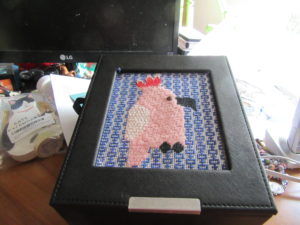
Updated January 7, 2022.
Here’s a batch of great needlepoint tips:
~ Don’t make needlepoint stitches which cross over more than 10 threads, they will snag too easily.
~ Diagonal stitches distort the canvas more than other kinds of stitches.
~ You can use a longer than usual thread when you are working Bargello, the longer stitches put less wear on the thread.
~ Sailors often made woolen pictures while on long sea voyages. These were called “woolies.”
~ When making a sampler of your own, try to pick traditional designs which won’t look dated later.
~ Leave a wider margin on the side of any canvas you cut, so you have plenty of room to add a border.
~ If you feel confident of your drawing skills, try drawing an outline directly on canvas using ZIG fabric markers.
~ If you are trying painting on canvas, do a “trial run” on a blank peice of canvas to get used to the paints and brush.
~ You can make a rich solid color background by using two similar shades from different color families of the same color (i.e.two pinks).
~ Blend two close shades in the same needle for a richer color. This is great for backgrounds.
~ Work wide (1 inch) stripes in tent stitch in two close colors for a great background. Or the same color in two different threads.
~ Highlight your wool needlepoint by adding a few stitches in silk in the same color.
~ Changing the width of a border can change the look of a design.
~ Wide borders become significant parts of the design, while narrow borders just set off the central area.
~ A central motif which overlaps part of the border is an overflowing motif. It’s a powerful design tool.
~ Check for missed stitches before blocking by holding your needlepoint up to the light, the missed stitches will be easy to see.
~ Sewing two pieces of needlepoint together is called “joining.”
~ Don’t want to frame, make your needlepoint as a wallhanging and attach to the wall with Velcro strips.
~ If you are stitching with black or shiny metallics, keep the stitches simple, complex stitches won’t show up.
~ Stash Sampler idea: Gather all your threads of one color (or several related colors) and use them for a geometric design.
~ Interlock canvas is made of shorter threads than mono canvas so it is harder on your stitching thread. Use shorter lengths to reduce wear.
~ If your chosen stitch doesn’t fit the border evenly, make corner blocks in another stitch and use them to make up the difference.
~ If your finished needlepoint is smaller than where it will go a simple Gobelin border in a thread from the piece will act as a needlepoint mat.
~ Do a section of each stitch you will be using in a project, to have your stitch guide with you always.
~ An easy way to store needles is to cut pieces of felt the size of business cards, put your needle into them & store them in plastic business card holders — one piece of felt for each size!
~ Interlock canvas does not ravel when it is cut. This makes it perfect for curved pieces and for parts of clothing.
~ You can use a footstool to take some stress off your feet and make stitching more comfortable.
~ Running your thread over a slightly damp sponge works great to control static.
~ You can use plastic canvas as interfacing instead of cardboard in needlepoint.
~ You can use a large size needle as a laying tool.
If you liked these tips and want more, why not get a copy of my book, Needlepoint Trade Secrets? It’s packed full of tips about needlepoint from start to finish. You can buy it at your local needlework store, from Amazon.com (here) or from Nordic Needle.
About Janet M Perry
Janet Perry is the Internet's leading authority on needlepoint. She designs, teaches and writes, getting raves from her fans for her innovative techniques, extensive knowledge and generous teaching style. A leading writer of stitch guides, she blogs here and lives on an island in the northeast corner of the SF Bay with her family

[…] June Random Thoughts on Needlepoint […]